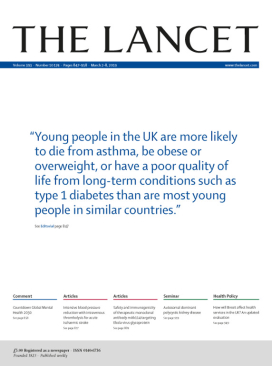Related Research Articles

Iraq Body Count project (IBC) is a web-based effort to record civilian deaths resulting from the US-led 2003 invasion of Iraq. Included are deaths attributable to coalition and insurgent military action, sectarian violence and criminal violence, which refers to excess civilian deaths caused by criminal action resulting from the breakdown in law and order which followed the coalition invasion. As of February 2019, the IBC has recorded 183,249 – 205,785 civilian deaths. The IBC has a media-centered approach to counting and documenting the deaths. Other sources have provided differing estimates of deaths, some much higher. See Casualties of the Iraq War.

Estimates of the casualties from the Iraq War have come in several forms, and those estimates of different types of Iraq War casualties vary greatly.

The Lancet is a weekly peer-reviewed general medical journal and one of the oldest of its kind. It is also one of the world's highest-impact academic journals. It was founded in England in 1823.

The Lancet, one of the oldest scientific medical journals in the world, published two peer-reviewed studies on the effect of the 2003 invasion of Iraq and subsequent occupation on the Iraqi mortality rate. The first was published in 2004; the second in 2006. The studies estimate the number of excess deaths caused by the occupation, both direct and indirect.
On 6 August 1990, four days after the Iraqi invasion of Kuwait, the United Nations Security Council (UNSC) placed a comprehensive embargo on Iraq. The sanctions stayed largely in force until 22 May 2003, and persisted in part, including reparations to Kuwait. The original stated purposes of the sanctions were to compel Iraq to withdraw from Kuwait, to pay reparations, and to disclose and eliminate any weapons of mass destruction (WMD).

The Iraq War was a protracted armed conflict in Iraq from 2003 to 2011. It began with the invasion of Iraq by the United States-led coalition that overthrew the Ba'athist government of Saddam Hussein. The conflict continued for much of the next decade as an insurgency emerged to oppose the coalition forces and the post-invasion Iraqi government. US troops were officially withdrawn in 2011. The United States became re-involved in 2014 at the head of a new coalition, and the insurgency and many dimensions of the armed conflict are ongoing. The invasion occurred as part of the George W. Bush administration's war on terror following the September 11 attacks.
Les Roberts is an American epidemiologist. He was the first winner of the Centers for Disease Control's Paul C. Schnitker Award for contributions to global health. He became prominent in the news just before the 2004 U.S. presidential election for his study estimating that 100,000 Iraqi civilians had been killed in the Iraq war at a time when official U.S. government counts were much lower. When a 2006 follow-up study confirmed the report, U.S. President George W. Bush dismissed it, saying the approach had been "pretty well discredited", without explaining how.
Since the 2003 invasion of Iraq, Iraqi academics have frequently been threatened with violence, kidnapped, or murdered. Although it is impossible to determine the exact scale of the violence and intimidation, the Iraqi Ministry of Higher Education reported that over 3,250 academics had fled the country between February and August 2006. According to the Iraqi Association of University Lecturers about 300 academics, including Ph.D.'s working in Iraqi government ministries and university administrators, had been killed before January, 2007. Other, less reliable, sources have placed the death toll as low as 20 and as high as 1,000.
Ali al-Shemari is an Iraqi politician from the Sadrist Movement who was the Health Minister of Iraq from May 20, 2006, until April 16, 2007.

The emerging field of conflict epidemiology offers a more accurate method to measure deaths caused during violent conflicts or wars that can generate more reliable numbers than before to guide decision-makers.
On Friday, 14 September 2007, ORB International, an independent polling agency located in London, published estimates of the total war casualties in Iraq since the US-led invasion of Iraq in 2003. At over 1.2 million deaths (1,220,580), this estimate is the highest number published so far. From the poll margin of error of +/-2.5% ORB calculated a range of 733,158 to 1,446,063 deaths. The ORB estimate was performed by a random survey of 1,720 adults aged 18+, out of which 1,499 responded, in fifteen of the eighteen governorates within Iraq, between August 12 and August 19, 2007. In comparison, the 2006 Lancet survey suggested almost half this number through the end of June 2006. The Lancet authors calculated a range of 392,979 to 942,636 deaths.

Events in the year 2008 in Iraq.
Dr. Salih Mahdi Motlab al-Hasnawi is an Iraqi doctor and politician, who has been the Minister of Health since 30 October 2007. He is a Shia Muslim, but independent of any political party.
The Iraq War resulted in multiple humanitarian crises.

The Iraq War started with a US-led invasion on 20 March 2003, causing much damage to the capital city, Baghdad. The war and collateral damage continued for years.
The Iraq War documents leak is the disclosure to WikiLeaks of 391,832 United States Army field reports, also called the Iraq War Logs, of the Iraq War from 2004 to 2009 and published on the Internet on 22 October 2010. The files record 66,081 civilian deaths out of 109,000 recorded deaths. The leak resulted in the Iraq Body Count (IBC) project adding 15,000 civilian deaths to their count, bringing their total to over 150,000, with roughly 80% of those civilians. It is the biggest leak in the military history of the United States, surpassing the Afghan War documents leak of 25 July 2010.
The Sisterhood Method is a household survey to estimate maternal deaths recommended by the World Health Organization (WHO). Although maternal deaths are a major problem in developing countries, high quality data are rare. Yet, numbers are needed for planning in order to reduce the problem of maternal death. Several methods have been used to estimate maternal deaths. According to the WHO, "The approach was designed to overcome the problem of large sample sizes and thus reduce cost."
The Million Death Study (MDS) is an ongoing human premature mortality study conducted in India. It began in 1998 and end in 2014. Among a sample size of 14 million Indians, approximately 1 million deaths are assigned medical causes through the Verbal Autopsy method to determine disease patterns and direct public health policy. The principal investigator of the study is Dr. Prabhat Jha, director of the Centre for Global Health Research and professor of epidemiology at the Dalla Lana School of Public Health, University of Toronto, Canada.

Casualty recording is the systematic and continuous process of documenting individual direct deaths from armed conflict or widespread violence. It aims to create a comprehensive account of all deaths within a determined scope, usually bound by time and location.

Undercounting of COVID-19 pandemic deaths has been witnessed around the world. Global mortality excess estimates by the World Health Organization are significantly different from official figures, pointing to undercounting– "while 1,813,188 COVID-19 deaths were reported in 2020... WHO estimates suggest an excess mortality of at least 3,000,000." The global average for underreporting COVID-19 deaths in cities is 30%. The aim of arriving at a truer death count is ultimately linked to improving national and international abilities and responses to fighting the virus. Undercounting can cause a number of problems such as delay in vaccines to priority populations.
References
- ↑ "New study estimates 151 000 violent Iraqi deaths since 2003 invasion". January 9, 2008 news release. World Health Organization. See right sidebar for related links.
- ↑ Alkhuzai AH, Ahmad IJ, Hweel MJ, Ismail TW, et al. (2008). "Violence-Related Mortality in Iraq from 2002 to 2006". New England Journal of Medicine . 358 (2): 484–93. doi: 10.1056/NEJMsa0707782 . PMID 18184950. January 31, 2008. Supplementary Appendix provided by the authors:
- ↑ "New study says 151,000 Iraqi dead". January 10, 2008. BBC News Online.
- ↑ "151,000 civilians killed since Iraq invasion". By Sarah Boseley. January 10, 2008. The Guardian .
- ↑ "W.H.O. Says Iraq Civilian Death Toll Higher Than Cited". By Lawrence K. Altman and Richard A. Oppel Jr.. January 10, 2008. New York Times.
- 1 2 "Violence-Related Mortality in Iraq from 2002 to 2006". New England Journal of Medicine. 358 (5): 484–493. January 31, 2008. doi: 10.1056/NEJMsa0707782 . PMID 18184950.
- ↑ "WHO | New study estimates 151 000 violent Iraqi deaths since 2003 invasion". WHO. Archived from the original on January 10, 2008.
- ↑ [ dead link ]
- ↑ [ dead link ]
- ↑ "Estimating Excess Mortality in Post-Invasion Iraq". By Catherine A. Brownstein, M.P.H., and John S. Brownstein, Ph.D.. January 31, 2008. New England Journal of Medicine.
- 1 2 "New Estimate of Violent Deaths Among Iraqis Is Lower". By David Brown and Joshua Partlow. January 10, 2008. Washington Post .
- ↑ "W.H.O. Says Iraq Civilian Death Toll Higher Than Cited" By Lawrence K. Altman and Richard A. Oppel Jr. January 10, 2008. The New York Times .
- ↑ "How many civilian deaths in Iraq since invasion?". By John Catalinotto. January 18, 2008. Workers World.
- ↑ "Lancet Study Author Assesses New Report on Iraqi Death Toll" Archived 2008-04-11 at the Wayback Machine . January 11, 2008. Institute for Public Accuracy.
- ↑ "Though Numbers Unclear, Iraqi Deaths Touch Many". by Lourdes Garcia-Navarro. Feb. 24, 2009. Morning Edition. National Public Radio.
- 1 2 War Deaths Spark Controversy in NEJM. July 23, 2008. By Peggy Peck, Executive Editor, MedPage Today. Reviewed by Zalman S. Agus, MD; Emeritus Professor, University of Pennsylvania School of Medicine.
- 1 2 [ dead link ]
- 1 2 "Right-Wingers Can't Cover Up Iraq's Death Toll Catastrophe". By John Tirman. January 21, 2008. AlterNet.
- ↑ "IRAQ: Civilian Deaths Massive by Any Measure" Archived 2008-12-06 at the Wayback Machine . By Haider Rizvi. January 11, 2008. Inter Press Service News Agency.
- ↑ "Lancet Study Author Assesses New Report on Iraqi Death Toll". January 11, 2008. Institute for Public Accuracy.
- ↑ "Counting Iraqi Casualties -- and a Media Controversy". By John Tirman. February 14, 2008. Editor and Publisher.
- 1 2 3 "Iraqi death toll estimates go as high as 150,000". Taipei Times. Nov 11, 2006.
- 1 2 "Iraqi health minister estimates as many as 150,000 Iraqis killed by insurgents". International Herald Tribune. Nov. 9, 2006.
- ↑ "Official: 150,000 Iraqis Killed Since 2003". CBS News. November 9, 2006.
- 1 2 "Iraqi Official: 150,000 Civilians Dead". Washington Post. Steven R. Hurst. Nov. 10, 2006.